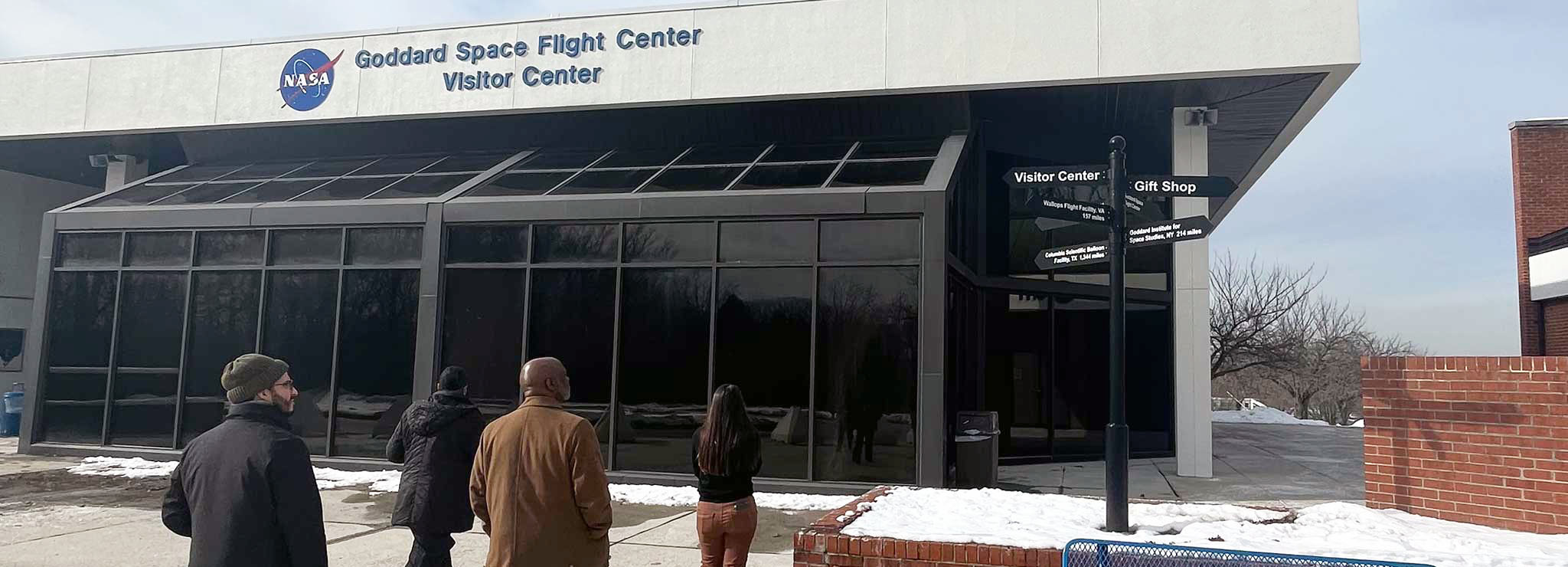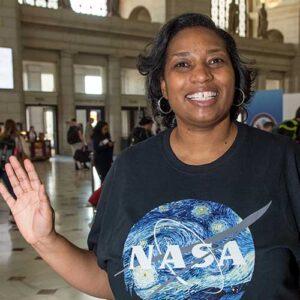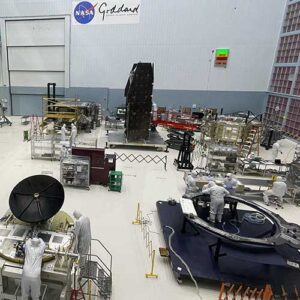
Earlier this year, Challenger Center’s Education Team experienced the opportunity of a lifetime—a VIP tour of NASA Goddard Space Flight Center! If you don’t already know, Goddard is NASA’s premiere space flight complex in Maryland, critical in carrying out NASA’s missions of space exploration and scientific discovery. It’s home to Hubble operations, proving ground for the recently launched James Webb Space Telescope, communications between mission control and astronauts aboard the International Space Station, and much more.
This once-in-a-lifetime experience was special to our team: In developing Challenger Center’s programs, particularly our simulated space missions, we take inspiration from the amazing work of NASA specialists. Witnessing their projects up close gave us insight into the reality of space exploration, their aspirations in exploring space, and our shared curiosity about humanity’s place in space.
An Inspiring Day with Dr. Trena Ferrell
 As soon as we arrived at the Visitor Center, we were met by Dr. Trena Ferrell, NASA Goddard Space Flight Center’s Earth Science Education and Public Outreach Lead. Her team provides programs to students and groups about all the incredible research scientists, engineers, and even seamstresses are doing at NASA.
As soon as we arrived at the Visitor Center, we were met by Dr. Trena Ferrell, NASA Goddard Space Flight Center’s Earth Science Education and Public Outreach Lead. Her team provides programs to students and groups about all the incredible research scientists, engineers, and even seamstresses are doing at NASA.
We began our tour with Dr. Ferrell at the helm and learned how each of the 50+ NASA facilities supports past, present, and future missions. As we traversed the 1,121-acre Goddard facility, Dr. Ferrell shared inspiring tidbits of information, like how after the James Webb Telescope launched and successfully deployed, NASA Goddard quickly started working on the next generation of space telescopes and observers.
She also provided connections between Challenger Center’s programs and NASA’s work today, including roles and careers outside conventional STEM fields. These unconventional careers are just as crucial as traditional STEM careers to NASA’s ambitions. Today, students truly have a myriad of creative options for participating in NASA and its mission.
NASA’s Seamstress Team
 One of these amazing, unconventional careers is that of seamstress. During our tour, we saw materials used to make the protective shielding that covers satellites (think of it as spacesuits for a spacecraft). These multi-layered blanket-like materials are made of materials like mylar, a shiny material that helps satellites maintain a stable temperature as they float in the void of space and protects them from the degradation of cosmic radiation.
One of these amazing, unconventional careers is that of seamstress. During our tour, we saw materials used to make the protective shielding that covers satellites (think of it as spacesuits for a spacecraft). These multi-layered blanket-like materials are made of materials like mylar, a shiny material that helps satellites maintain a stable temperature as they float in the void of space and protects them from the degradation of cosmic radiation.
As the team traversed across the sewing machine-filled tables, we met Paula Cain, who began working in fashion design for Disney. Later, while searching job advertisements, Paula stumbled upon one seeking someone who liked Star Trek … and ended up working for NASA as a seamstress! Paula shared that their biggest inspiration is that NASA offers career opportunities beyond astronauts, scientists, and engineers–opening space exploration to artists and creators like themselves.
Paula now leads a team of seamstresses to make NASA’s specialized thermal blankets. Some of the missions they’ve worked on include the International Space Station, the James Webb Telescope, and currently on the forthcoming launch of the Nancy Grace Roman Space Telescope.
Drills and Centrifuges and Telescopes–Oh, My!
We also had the chance to see some of the tools used by astronauts during EVAs, including specialized screwdrivers and drills that work in the harsh microgravity environment, like the Hubble Space Telescope missions. One of the drills for the mission had special drill bits that held nuts and bolts together so they wouldn’t float freely in microgravity, damaging other parts of the telescope or the International Space Station.

Next, we saw the High Capacity Centrifuge, a 120-foot diameter arm that simulates the gravitational loads of launch and landing on equipment like satellites. It can accelerate payloads up to 30 G’s of force and transmits real-time data from the payload during testing to computers in a separate control room for analysis. Amazingly, we saw the centrifuge’s round room, which sported some large dents due to flying payloads–yikes!
But, one of the most impressive projects we saw was construction on the Nancy Grace Roman telescope, which is set to launch in October 2026 (and no later than May 2027). This telescope will survey large swaths of space from our solar system to the edge of the observable universe, exploring exoplanets and, most interestingly, dark energy and matter. It will use high-speed surveying and high-resolution instruments to provide the best information on how dark energy and dark matter behave amongst the galaxies and galaxy clusters. The telescope will employ three types of data-collecting techniques: Microlensing, direct imaging, and transits.
Using Real-World Scenarios for Challenger Center Programs
 We left this experience with fresh ideas for current and future Challenger Center programs. We enjoyed seeing and meeting teams who work on projects beyond science and engineering, prompting ideas for inspiring students to think critically beyond STEM fields. Seeing current and upcoming missions awoke a sense of direction in our pursuit to inspire students. There’s so much more to explore and to know from our universe and planet, Earth. This incredible experience reaffirmed our mission to provide students with opportunities to see themselves in STEM and let their curiosity drive them to know more about the universe and our place in it.
We left this experience with fresh ideas for current and future Challenger Center programs. We enjoyed seeing and meeting teams who work on projects beyond science and engineering, prompting ideas for inspiring students to think critically beyond STEM fields. Seeing current and upcoming missions awoke a sense of direction in our pursuit to inspire students. There’s so much more to explore and to know from our universe and planet, Earth. This incredible experience reaffirmed our mission to provide students with opportunities to see themselves in STEM and let their curiosity drive them to know more about the universe and our place in it.
Visits like these are important for our Education Team for various reasons; most importantly, they help us develop and update Challenger Center’s programs using real-world scenarios. As we develop our simulated missions, we use real-world images, data, and research to develop the tools and interactive activities, like DNA extraction, medical tests, and orbital mechanics to help navigate our simulated spacecraft. We connect with subject matter experts to understand their expertise and experiences. We’re committed to ensuring the realness of space exploration in our Center Missions and Virtual Missions so students understand that one day, they, too, can participate in space exploration.
